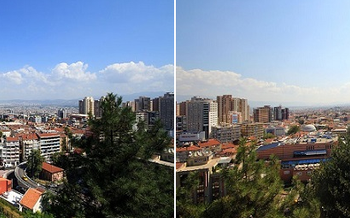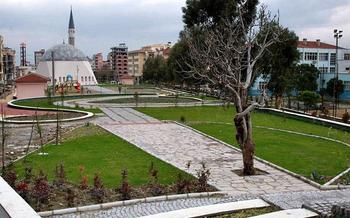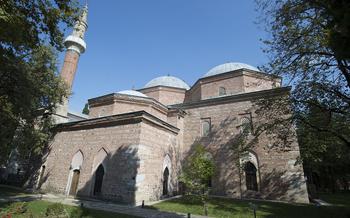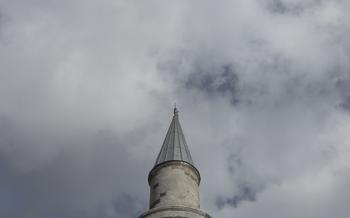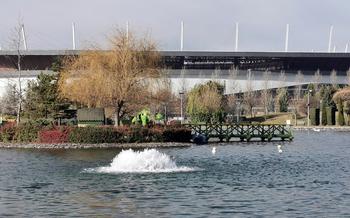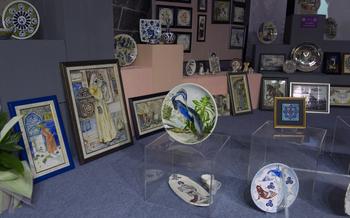
Kursunlu Complex
- Historical Background
- Location and Accessibility
- Architectural Highlights
- The Mosque
- The Madrasah
- The Imaret
- The Hammam
- The Caravanserai
- The Museum
- The Garden
- Visitor Information
- Tips for Photography Enthusiasts
- Local Cuisine and Dining Options
- Shopping and Souvenirs
- Insider Tip: Unveiling Hidden Treasures and Unique Experiences
Historical Background
The Kursunlu Complex stands as a testament to the rich history and architectural heritage of Eskişehir. Built in the 16th century during the reign of the Ottoman Empire, it served as a hub of religious, educational, and social activities. The complex bears the legacy of the Ottoman architectural style, blending traditional Islamic elements with Anatolian influences. Its construction played a pivotal role in the development of Eskişehir, transforming it into a thriving center of trade, education, and culture. Over the centuries, the Kursunlu Complex has witnessed the ebb and flow of history, adapting to changing times while preserving its essence as a symbol of Eskişehir's heritage.
Location and Accessibility
The Kursunlu Complex is strategically situated in the heart of Eskişehir, a vibrant city in northwestern Turkey. Its exact location is on Kursunlu Street, within easy reach of many other notable attractions. Visitors can conveniently reach the complex via various transportation options. The most convenient way to get there is by taking a taxi or renting a car. There are also public transportation options, such as buses and trams, that stop nearby.
Once you arrive in the area, you will be greeted by the impressive sight of the complex's grand entrance. As you step inside, you will find yourself in a serene and tranquil courtyard, surrounded by the various buildings that make up this architectural masterpiece. Take a moment to pause and admire the stunning views that unfold before you.
Architectural Highlights
The Kursunlu Complex boasts a unique blend of architectural styles and influences, reflecting its rich history and cultural significance. The mosque stands as the centerpiece of the complex, showcasing intricate tilework, graceful arches, and a majestic dome. Its minaret, adorned with traditional Islamic motifs, serves as a beacon of faith and a symbol of the city's skyline.
The madrasah, where students once pursued Islamic studies, features a series of domed chambers and arcaded courtyards. Each chamber is adorned with vibrant Iznik tiles, geometric patterns, and decorative calligraphy, creating a visually stunning and inspiring learning environment.
The imaret, or soup kitchen, embodies the spirit of community and benevolence. Its vast kitchen, equipped with traditional ovens and cooking utensils, speaks to the generosity and hospitality of the complex's founders. The dining hall, with its long rows of tables and benches, evokes a sense of communal dining and social interaction.
The hamam, or bathhouse, is an architectural marvel that showcases the importance of cleanliness and well-being in Islamic culture. Its intricate plumbing system, consisting of hot and cold water chambers, ensures a luxurious bathing experience. The domed ceilings, decorated with intricate designs, create a serene and relaxing atmosphere.
The caravanserai, a resting place for weary travelers, features a large courtyard surrounded by arched alcoves. These alcoves, once used by merchants and their caravans, provided shelter and security during their long journeys. The caravanserai's strategic location on the trade routes made it a vital hub for commerce and cultural exchange.
Throughout the complex, the use of local materials and traditional construction techniques adds to its authenticity. The combination of stone, brick, and wood creates a harmonious blend of functionality and aesthetics. The attention to detail and the skillful craftsmanship exhibited in every corner of the complex make it a true architectural masterpiece.
The Mosque
The mosque, the heart of the Kursunlu Complex, stands as a testament to the architectural prowess of the Seljuk era. Constructed during the reign of Sultan Alaeddin Keykubat I in the 13th century, the mosque boasts a harmonious blend of Seljuk and Anatolian architectural styles. Its striking features include a rectangular prayer hall, a towering minaret, and a serene courtyard that invites contemplation and tranquility.
The prayer hall, adorned with intricate tilework and calligraphy, exudes an aura of reverence. The mihrab, the focal point of the hall, is a masterpiece of craftsmanship, featuring delicate carvings and vibrant colors that draw the eye. The lofty dome, supported by elegant columns, creates a sense of spaciousness and grandeur, while the stained-glass windows filter the sunlight, casting a warm glow upon the interior.
The minaret, a symbol of divine presence, rises majestically from the mosque's corner. Its slender cylindrical form, adorned with geometric patterns and Quranic inscriptions, serves as a beacon guiding the faithful to prayer. The intricate brickwork and tilework that embellish the minaret showcase the exceptional artistry of Seljuk masons.
The courtyard, a sanctuary of peace and tranquility, provides a serene space for contemplation and reflection. Surrounded by lush gardens and adorned with fountains, the courtyard offers a welcome respite from the bustling city. The ablution fountain, with its intricate carvings and flowing water, adds a touch of tranquility to the sacred space.
The Madrasah
The madrasah, or Islamic school, is a prominent feature of the Kursunlu Complex. Built during the reign of Sultan Bayezid II in the 15th century, it served as a center of Islamic education and scholarship for centuries. The madrasah comprises a series of classrooms, a library, and a courtyard, all arranged around a central dome.
The classrooms are spacious and well-lit, with large windows that provide ample natural light. The library, located on the upper floor, houses a collection of valuable manuscripts and books on various Islamic subjects. The courtyard, a serene and tranquil space, is surrounded by a colonnade of arches and features a central fountain.
The madrasah played a crucial role in the development of Islamic scholarship in Eskişehir. It attracted students from all over the region, who came to study under renowned scholars and theologians. The madrasah's graduates went on to become influential figures in the fields of Islamic law, theology, and philosophy.
Today, the madrasah is no longer in use as an educational institution. However, it remains an important historical and architectural landmark, and it is open to visitors who wish to explore its rich history and admire its beautiful architecture.
The Imaret
The imaret, a crucial component of the Kursunlu Complex, played a pivotal role in providing sustenance and support to the community. This charitable institution functioned as a soup kitchen, distributing meals to the needy and travelers who sought refuge within the complex's walls. The imaret's design reflected its purpose, featuring a spacious kitchen equipped with large cauldrons for cooking, a dining hall where recipients could gather and partake in their meals, and storage areas to ensure a steady supply of provisions.
Beyond its practical function, the imaret held significant social and cultural value. It served as a gathering place for people from all walks of life, fostering a sense of community and solidarity. The act of sharing meals together strengthened bonds and promoted social interaction, creating a welcoming and inclusive environment within the complex. Moreover, the imaret's charitable mission exemplified the Islamic principles of compassion, generosity, and care for the less fortunate, leaving a lasting legacy of humanitarianism and social responsibility.
The Hammam
The hamam, or Turkish bath, is an integral part of Turkish culture, deeply rooted in history and tradition. The Kursunlu Complex boasts a splendid hamam, a testament to the importance of cleanliness and social interaction in Ottoman society. Built to cater to the needs of travelers and locals alike, the hamam provided a communal space for relaxation and rejuvenation.
The hamam is divided into distinct sections, each serving a specific purpose. Visitors first enter the changing room, where they can disrobe and prepare for their bathing experience. The heart of the hamam is the sıcaklık, or hot room, which features a central marble platform called the göbek taşı. Here, bathers can recline on the heated platform and enjoy a thorough scrub and massage by experienced tellaks, or bath attendants.
After the invigorating scrub, bathers move to the ılıklık, or warm room, which serves as a transition zone between the hot and cold areas. Here, they can relax and allow their bodies to cool down gradually before entering the soğukluk, or cold room. The soğukluk provides a refreshing contrast to the hot and warm rooms, helping to close the pores and stimulate circulation.
The Kursunlu Hamam is not merely a place for physical cleansing; it also holds cultural and social significance. In the past, the hamam was a place where people from all walks of life could come together, socialize, and exchange news and ideas. It was a place where friendships were forged, and bonds were strengthened. Today, the hamam continues to be a popular destination for both locals and tourists seeking an authentic Turkish bathing experience.
The Caravanserai
The Kursunlu Complex also features a caravanserai, a traditional resting place for travelers and traders in the past. Constructed during the Ottoman period, the caravanserai played a crucial role in facilitating trade and commerce along the Silk Road. Its strategic location provided weary travelers with a safe haven to rest, replenish their supplies, and exchange goods.
The caravanserai is a testament to the ingenuity and architectural prowess of the Ottoman Empire. It features a spacious courtyard surrounded by two-story buildings that housed guest rooms, stables, and storage areas. The courtyard provided a communal space for travelers to socialize, exchange stories, and conduct business transactions.
The caravanserai's architectural design reflects the practical needs of travelers. Guest rooms were arranged around the courtyard, offering easy access and security. Stables were located on the ground floor to provide shelter for animals, while storage areas were strategically placed to facilitate the loading and unloading of goods.
Today, the caravanserai within the Kursunlu Complex stands as a reminder of Turkey's rich history as a crossroads of civilizations. Although no longer functioning as a resting place for travelers, it offers visitors a glimpse into the past and the important role that the caravanserai played in shaping the region's cultural and economic development.
The Museum
The Kursunlu Complex houses a captivating museum that delves into the rich history and significance of this remarkable site. Through interactive displays and educational programs, visitors can embark on a journey through time, exploring the various structures and their contributions to the cultural heritage of Eskişehir.
The museum showcases a diverse collection of artifacts, including architectural fragments, pottery, and manuscripts that provide valuable insights into the daily lives of those who inhabited the complex. These exhibits offer a glimpse into the social, religious, and economic aspects of this vibrant community.
One of the highlights of the museum is a scale model of the Kursunlu Complex, meticulously crafted to showcase the intricate details of its architecture. This model allows visitors to visualize the complex in its entirety and gain a deeper appreciation for its grand design.
Another captivating exhibit focuses on the restoration process of the complex, shedding light on the painstaking efforts undertaken to preserve this historical treasure. Visitors can learn about the techniques and materials used to restore the buildings to their former glory, ensuring their legacy for generations to come.
The museum also hosts temporary exhibitions that explore various aspects of Turkish culture and history, offering visitors a chance to delve deeper into the diverse heritage of the region. These exhibitions often feature works by local artists, artisans, and historians, showcasing the vibrant creative scene of Eskişehir.
The Garden
Amidst the historical structures of the Kursunlu Complex, a serene and tranquil garden invites visitors to find respite and tranquility. Landscaped with lush greenery, fragrant flowers, and towering trees, the garden offers a peaceful retreat from the bustling city. Visitors can stroll along the winding paths, admiring the vibrant colors and textures of the flora. Benches and gazebos provide opportunities to sit and soak in the tranquility of the surroundings. The garden also serves as a habitat for a variety of birds, creating a delightful symphony of chirping and singing. Whether seeking a moment of reflection or a break from exploring the complex, the garden offers a sanctuary for relaxation and rejuvenation.
Visitor Information
Operating Hours and Admission Fees
The Kursunlu Complex is open to visitors from 9 am to 5 pm, seven days a week. Admission to the complex and its museum is free of charge, allowing everyone to experience its rich history and architectural marvels without any financial barriers. This free access encourages locals and tourists alike to explore and appreciate the complex's cultural significance.
Guided Tours and Self-Guided Exploration
For those seeking a deeper understanding of the complex's history and architecture, guided tours are available at a nominal fee. Led by knowledgeable guides, these tours provide insightful commentary and anecdotes, bringing the complex's past to life. Visitors can also opt for self-guided exploration, allowing them to wander at their own pace and immerse themselves in the serene ambiance.
Accessibility for Visitors with Disabilities
The Kursunlu Complex is committed to ensuring accessibility for visitors with disabilities. Ramps and elevators have been installed throughout the complex, making it easy for wheelchair users and individuals with limited mobility to navigate the grounds and explore the buildings. Accessible restrooms are also available for the convenience of visitors.
Tips for Photography Enthusiasts
The Kursunlu Complex offers a treasure trove of photographic opportunities, with its stunning architecture, serene gardens, and vibrant atmosphere. To capture the best shots, plan your visit during the golden hours of sunrise or sunset, when the warm light casts a magical glow on the complex. Explore different angles and perspectives to showcase the intricate details and grandeur of the buildings. Experiment with natural light and composition to create dramatic and visually compelling images. Don't forget to capture the lively energy of the surrounding streets and the interactions of locals going about their daily lives. With a keen eye and a touch of creativity, you can create a stunning portfolio of images that will forever immortalize the beauty of the Kursunlu Complex.
Local Cuisine and Dining Options
When visiting the Kursunlu Complex, immerse yourself in the flavors of traditional Turkish cuisine. The surrounding area offers a delightful array of restaurants and cafes, each serving up mouthwatering dishes that reflect the region's rich culinary heritage.
Indulge in the tantalizing aromas of freshly baked pide, a boat-shaped flatbread filled with savory meats, cheese, or vegetables. Sample the delectable kebabs, grilled to perfection and served with aromatic spices and zesty sauces. For a taste of local delicacies, try the gözleme, a thin flatbread stuffed with spinach, cheese, or minced meat.
Vegetarians will delight in the variety of meze, an assortment of small dishes that showcase the vibrant flavors of Turkish cuisine. From hummus and baba ghanoush to stuffed grape leaves and pickled vegetables, these appetizers are perfect for sharing and savoring.
Don't miss the chance to sip on a refreshing glass of Turkish tea, a staple beverage that accompanies many meals and social gatherings. For a sweet treat, indulge in the heavenly delight of künefe, a crispy pastry filled with melted cheese and topped with a sweet syrup.
Whether you choose to dine in a traditional Turkish restaurant or grab a quick bite at a local café, the culinary experiences surrounding the Kursunlu Complex are sure to tantalize your taste buds and leave you craving for more.
Shopping and Souvenirs
The Kursunlu Complex and its surroundings offer a vibrant shopping experience, allowing visitors to take home unique pieces of Turkish craftsmanship. Local markets and bazaars, such as the historic Eskişehir Bazaar, are treasure troves of traditional handicrafts, carpets, pottery, jewelry, and souvenirs. Visitors can haggle with friendly vendors and discover hidden gems that reflect the rich cultural heritage of the region.
Supporting local artisans and preserving traditional crafts is essential to sustaining the vibrant cultural tapestry of Turkey. By purchasing handmade items, visitors contribute directly to the livelihoods of skilled craftspeople and help keep ancient traditions alive. Whether it's a hand-painted ceramic plate, an intricately woven rug, or a piece of shimmering jewelry, each purchase carries a story and a connection to the talented artisans who create them.
When shopping in Eskişehir, it's essential to embrace the local customs and etiquette. Be prepared to engage in friendly bargaining, as it's an integral part of the shopping experience. Don't be afraid to ask questions about the products, as the vendors are usually happy to share their knowledge and stories behind their creations.
Remember, shopping in Turkey is not just about acquiring souvenirs; it's about immersing yourself in the local culture, connecting with the artisans, and preserving the traditions that make this country so unique.
Insider Tip: Unveiling Hidden Treasures and Unique Experiences
Beyond the main attractions of the Kursunlu Complex, there are hidden gems waiting to be discovered. For those seeking a deeper connection with the site's history and culture, here are some insider tips:
-
Explore the Underground Water Cisterns: Descend into the depths of the complex to discover a network of ancient water cisterns that once supplied water to the city. These subterranean chambers offer a glimpse into the engineering ingenuity of the past.
-
Attend a Traditional Turkish Coffee Ceremony: Immerse yourself in Turkish culture by participating in a traditional coffee ceremony within the complex. Savor the rich aroma and taste of freshly brewed Turkish coffee while learning about the rituals and customs surrounding this beloved beverage.
-
Discover the Secret Garden: Tucked away in a secluded corner of the complex lies a hidden garden that exudes tranquility and serenity. Stroll through its meandering paths, admire the vibrant flora, and find a peaceful spot to relax and reflect amidst nature's beauty.
-
Witness the Changing Seasons: The Kursunlu Complex transforms with each passing season. In spring, the garden bursts into bloom, creating a vibrant tapestry of colors. During the summer, the complex offers a cool respite from the heat, with its shaded courtyards and refreshing fountains. In autumn, the leaves turn golden and red, painting a breathtaking landscape. And in winter, the snow-covered rooftops and minarets create a magical, ethereal scene.
-
Engage with Local Artisans: The vicinity of the Kursunlu Complex is home to talented artisans who create unique handicrafts and souvenirs. Visit their workshops, observe their intricate craftsmanship, and purchase authentic pieces to cherish as mementos of your visit.
By venturing beyond the surface, you'll uncover the hidden treasures of the Kursunlu Complex and gain a deeper appreciation for its rich history and cultural significance.
